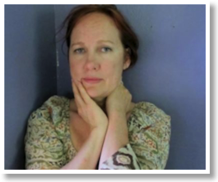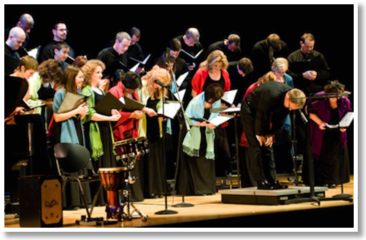May 2014
Iris DeMent
Iris DeMent
Cactus Café
Austin, TX
 After a 16-year break from recording, singer/songwriter Iris DeMent reemerged on the scene with a new country album, Sing the Delta. The singer introduced many of her latest pieces while treating the audience to some old favorites as well in her recent performances at the Cactus Café.
After a 16-year break from recording, singer/songwriter Iris DeMent reemerged on the scene with a new country album, Sing the Delta. The singer introduced many of her latest pieces while treating the audience to some old favorites as well in her recent performances at the Cactus Café.
With a quick, “Hey everybody,” she sat at the Baldwin baby grand piano and promptly launched into “When My Morning Comes Around.” Her voice’s piercing, nasal clarity harkens back to some of the country greats, such as Loretta Lynn or Tanya Tucker, giving her song a sense of familiarity and nostalgia.
Dement’s stiff cowboy boots made it difficult for her to smoothly use the piano’s pedals. Instead, she nonchalantly lifted her entire leg to change the pedal every time. This quirk seemed especially apt when the musician jokingly shared, “If I had my way, I’d sing behind a curtain.”
One of the most poignant songs was one inspired by a quote of Martin Luther King, Jr. The union of the lyrics and soulful harmonic progression packed a passionate punch. Together they communicated a powerful sincerity reminiscent of some of the original protest songs from the ‘60s. The fact that a few were moved to tears reflected the moving honesty of the emotion Dement conveyed through this piece.
The authenticity of her music and person endear DeMent to her audiences. Each song invites listeners to engage in the artist’s struggles in a profoundly human way.
by Jacqueline Perrin
Cactus Café
Austin, TX

With a quick, “Hey everybody,” she sat at the Baldwin baby grand piano and promptly launched into “When My Morning Comes Around.” Her voice’s piercing, nasal clarity harkens back to some of the country greats, such as Loretta Lynn or Tanya Tucker, giving her song a sense of familiarity and nostalgia.
Dement’s stiff cowboy boots made it difficult for her to smoothly use the piano’s pedals. Instead, she nonchalantly lifted her entire leg to change the pedal every time. This quirk seemed especially apt when the musician jokingly shared, “If I had my way, I’d sing behind a curtain.”
One of the most poignant songs was one inspired by a quote of Martin Luther King, Jr. The union of the lyrics and soulful harmonic progression packed a passionate punch. Together they communicated a powerful sincerity reminiscent of some of the original protest songs from the ‘60s. The fact that a few were moved to tears reflected the moving honesty of the emotion Dement conveyed through this piece.
The authenticity of her music and person endear DeMent to her audiences. Each song invites listeners to engage in the artist’s struggles in a profoundly human way.
by Jacqueline Perrin
Conspirare Symphonic Choir
Conspirare Symphonic Choir
University Presbyterian Church
Austin, TX
Photo credit: Karen Sachar
 With a motto as bold as “We sing life,” the Austin-based choral phenomenon, Conspirare, has a lot to prove. Fortunately they lived up to their rallying cry with their performance of “Moving Light.”
With a motto as bold as “We sing life,” the Austin-based choral phenomenon, Conspirare, has a lot to prove. Fortunately they lived up to their rallying cry with their performance of “Moving Light.”
After a brief speech of introduction, the five-time Grammy nominated choir filed on stage for the first half of the concert, featuring Morten Lauridsen’s Lux Aeterna. The first movement opened with a deep, soulful note on the organ. As soon as the pitch sounded, listeners collectively tilted their heads toward the ceiling where pink and orange lights appeared overhead.
Each of the five movements featured unique color combinations. During the second movement, blue orbs of light glided across the walls of the church.
The program text provides clarity as to the composer’s decision to make the character of the second movement so markedly different from the others: “To deliver us, you became human, / and did not disdain the Virgin’s womb. / Having blunted the sting of death, / You opened the kingdom of heaven to all believers.” The composer mirrors Jesus’ hardship, to which the passage is referring, in the harmonic and structural friction.
The choir’s unity was especially apparent in the fourth movement, “Veni, Sancto Spiritus,” which translates to “Come, Holy Spirit.” The voices worked as one entity, conveying their message with exuberance and conviction. The movement’s strong unison sections heightened the impact of the text, which comes in the form of a plea to the Holy Spirit to “Send forth from heaven / The ray of thy light.”
The final Alleluia, which ended the powerful work, seemed to envelope listeners warmly and completely.
For the second half of the program, four cloaked dancers positioned themselves in a circular formation at the center of the stage in front of the chorus to begin James Whitbourn’s Luminosity.
Each movement features texts attributed to famous luminaries throughout the ages. About his piece, Whitbourn wrote, “[Luminosity] is conceived with a visual counterpoint to the music in mind, coming in the form of art, dance and light as well as in the use of space. The focus in all the elements is on transcendent beauty and eternal love. It is likely to be symbolic, luminous and shapely in concept.”
The music began, and a silhouette of a lone female dancer made slow, deliberate movements behind a screen off to the side while the cloaked dancers held their positions.
The tanpura, a long-necked Indian lute, provided the heartbeat of the piece, sounding a regular ostinato pattern that wove its way in and out of the texture as the piece progressed.
Eventually the dancer behind the screen came into view. As she passed the cloaked dancers one by one, they moved in response to her presence.
The work’s aleatoric elements enhanced its humanity, and portrayed so deftly by the dancers’ organic movements. At one point, a waterfall of humming voices trickled down to form thick, lush harmonies.
Moments of tension and excitement punctuated the serenity, with the majestic strike of the gong, golden lights, and the dancers coming together to move in unison.
The beginning of the final movement featured a soprano solo. The fateful ostinato of the tanpura returned. Dancers reemerged when the chorus sang, “The cause of all this pain is sin.” Stars appeared on the ceiling above the musicians. The silhouetted dancer came forward and stood above the cloaked women, who crouched down and returned to the stillness from which they came.
Though the experimental concert format was a risky move, it ultimately paid off for Conspirare. The dancing and multimedia elements transfixed the audience. The animated applause and standing ovation that followered testified were a testament to the ensemble’s success. The works were beautifully executed with a critical blend of technique and artistry.
by Jacqueline Perrin
Editor’s note: In the interest of transparence, Ms. Perrin has recently auditioned for the choral group Conspirare.
University Presbyterian Church
Austin, TX
Photo credit: Karen Sachar

After a brief speech of introduction, the five-time Grammy nominated choir filed on stage for the first half of the concert, featuring Morten Lauridsen’s Lux Aeterna. The first movement opened with a deep, soulful note on the organ. As soon as the pitch sounded, listeners collectively tilted their heads toward the ceiling where pink and orange lights appeared overhead.
Each of the five movements featured unique color combinations. During the second movement, blue orbs of light glided across the walls of the church.
The program text provides clarity as to the composer’s decision to make the character of the second movement so markedly different from the others: “To deliver us, you became human, / and did not disdain the Virgin’s womb. / Having blunted the sting of death, / You opened the kingdom of heaven to all believers.” The composer mirrors Jesus’ hardship, to which the passage is referring, in the harmonic and structural friction.
The choir’s unity was especially apparent in the fourth movement, “Veni, Sancto Spiritus,” which translates to “Come, Holy Spirit.” The voices worked as one entity, conveying their message with exuberance and conviction. The movement’s strong unison sections heightened the impact of the text, which comes in the form of a plea to the Holy Spirit to “Send forth from heaven / The ray of thy light.”
The final Alleluia, which ended the powerful work, seemed to envelope listeners warmly and completely.
For the second half of the program, four cloaked dancers positioned themselves in a circular formation at the center of the stage in front of the chorus to begin James Whitbourn’s Luminosity.
Each movement features texts attributed to famous luminaries throughout the ages. About his piece, Whitbourn wrote, “[Luminosity] is conceived with a visual counterpoint to the music in mind, coming in the form of art, dance and light as well as in the use of space. The focus in all the elements is on transcendent beauty and eternal love. It is likely to be symbolic, luminous and shapely in concept.”
The music began, and a silhouette of a lone female dancer made slow, deliberate movements behind a screen off to the side while the cloaked dancers held their positions.
The tanpura, a long-necked Indian lute, provided the heartbeat of the piece, sounding a regular ostinato pattern that wove its way in and out of the texture as the piece progressed.
Eventually the dancer behind the screen came into view. As she passed the cloaked dancers one by one, they moved in response to her presence.
The work’s aleatoric elements enhanced its humanity, and portrayed so deftly by the dancers’ organic movements. At one point, a waterfall of humming voices trickled down to form thick, lush harmonies.
Moments of tension and excitement punctuated the serenity, with the majestic strike of the gong, golden lights, and the dancers coming together to move in unison.
The beginning of the final movement featured a soprano solo. The fateful ostinato of the tanpura returned. Dancers reemerged when the chorus sang, “The cause of all this pain is sin.” Stars appeared on the ceiling above the musicians. The silhouetted dancer came forward and stood above the cloaked women, who crouched down and returned to the stillness from which they came.
Though the experimental concert format was a risky move, it ultimately paid off for Conspirare. The dancing and multimedia elements transfixed the audience. The animated applause and standing ovation that followered testified were a testament to the ensemble’s success. The works were beautifully executed with a critical blend of technique and artistry.
by Jacqueline Perrin
Editor’s note: In the interest of transparence, Ms. Perrin has recently auditioned for the choral group Conspirare.


